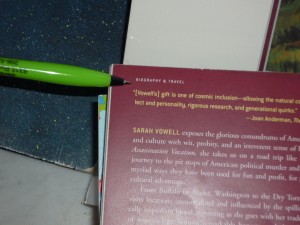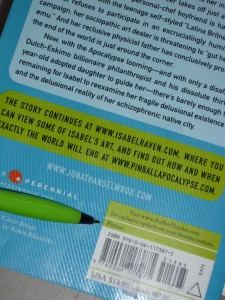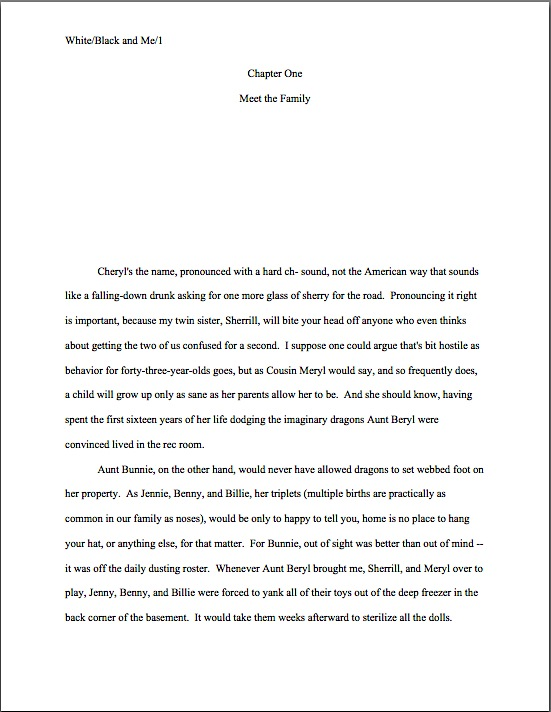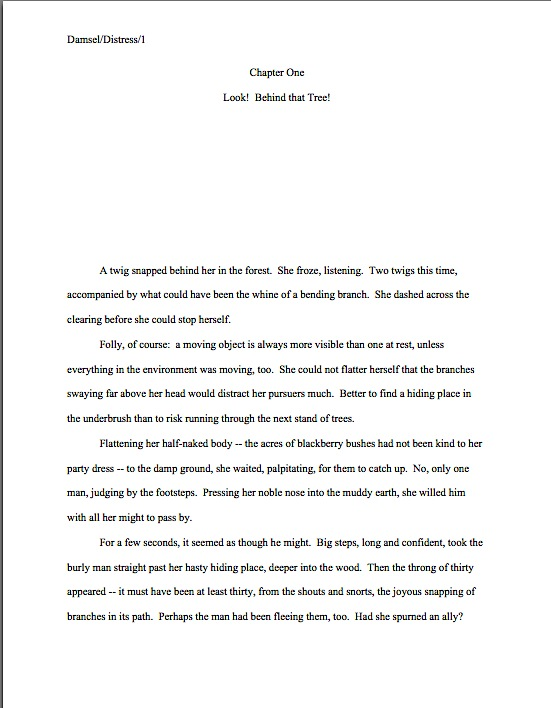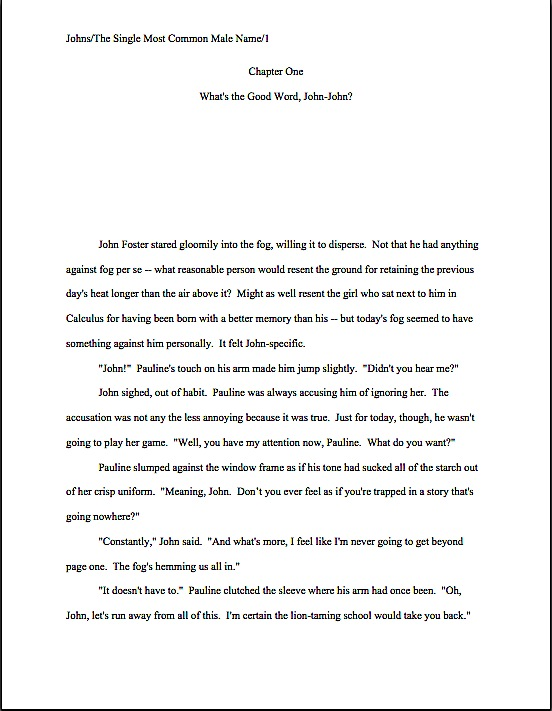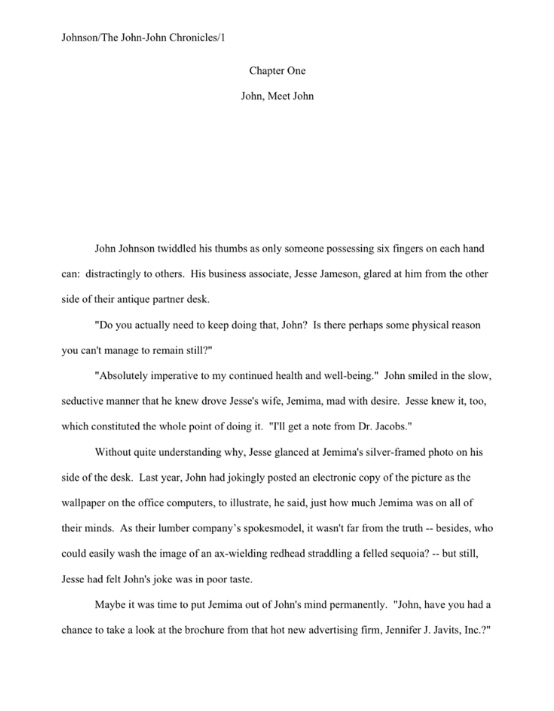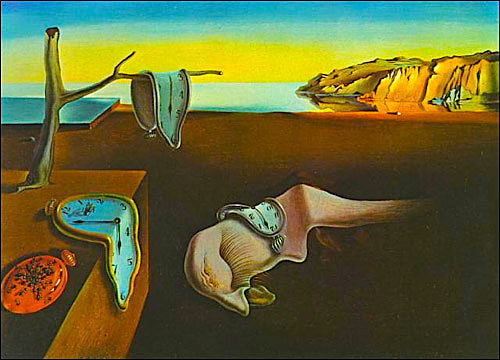
My, it’s quiet out there in the Author! Author! community. I’ve been hearing from some of you prospective pitchers privately — although again, it honestly does make more sense for readers to post questions in the comments here, rather than e-mailing me; that way, not only I am less likely to answer the same question fifteen times in a day, but other curious souls can see the answer — but for the most part, folks have been keeping the comments to a minimum throughout this series. It’s fine just to observe, of course, but I have to say, I am starting to worry that some of you with pitching opportunities coming up might be reluctant to come forward with your concerns and fears.
Call me zany, but it concerns me. It makes me fearful.
Please, if you have questions, ask them — I would much, much rather devote a bit of extra time to responding to comments than have even a single one of you walk into a pitching session unsure what to do. Use a pseudonym in the comments, if you like, but honestly, there’s no shame in feeling insecure. Believe me, you’re not the only prospective pitcher out there overcome with worry; your speaking up might even help someone who is too shy to ask.
Of course, the silence may also be attributable to shock at just how much there is to learn about pitching. We’ve covered a tremendous amount of territory over the last couple of weeks, you must admit. We’ve discussed how to identify your book’s publishing category, identifying your target market, coming up with graceful ways of letting an agent know how big that audience might be, come up with a few strong selling points, develop a snappy keynote statement, and pull all of these elements together into the magic first 100 words. All of that, my friends, will enable you to move gracefully and professionally into conversation with anyone even vaguely affiliated with the publishing industry.
Now you’re ready to start practicing what to say after that.
Oh, stop groaning — this is where it starts to get exciting. Now that we have the building blocks of the pitch assembled, from here on out, we’re going to be talking about what you should say after the agent of your dreams responds to your magic first hundred words with, “Why, yes, stalwart writer, I would like to hear more about this marvelous book of which you speak. Enlighten me further, humble scribe, and don’t forget to awe me.”
Okay, so maybe the average Manhattanite agent doesn’t speak like an extra in a production A MIDSUMMER NIGHT’S DREAM. (Not that anyone in my neck of the woods is dreaming much on these sticky midsummer nights. We had an impromptu block party at 3 am, just because no one could sleep.) The fact remains, if you’ve been following this series and doing your homework, you already have something prepared for that precious moment when someone in the industry turns to you and asks that question so dreaded by aspiring writers, “So what do you write?”
Now, we’re preparing for that even more fruitful moment when an agent sighs, glances longingly at the pasta bar just a few feet ahead of her, and says, “Yeah, sure, intrepid writer who has just accosted me while I was spooning wilted green salad onto my plate, you may have 30 seconds of my time. Do you mind if I finish making my way through the buffet first?”
Moments like this were just made for the elevator speech. Or, if you’re going to be polite about it — and you are, aren’t you, if only to make your mother and me proud? — the moments two minutes after a conversation like this, after the agent in question has had a chance to heap her plate to overflowing and set it down on a nearby table, were just made for this. So are the moments right after an agents’ panel, while you are waiting in line for any of the many, many conference festivities that seem for no apparent reason to require waiting in line, and fifteen minutes after the really nice first-time author with whom you’ve been chatting in that bar that’s never more than 100 yards from any writers’ conference in North America says, “Oh, there’s my agent. Mind if he joins us for a drink?”
Trust me, you will want to be prepared for these moments. Even if you are so terrified of the prospect of pitching that you have promised yourself that you will not utter word one about your manuscript until you have actually shaken hands with the agent with whom you have a scheduled meeting, you’re going to be a much, much happier camper if you have worked up something to say if asked in any context other than a formal pitch session.
Like, say, the entire rest of the conference.
Or, to put it another way: you know those 30 seconds that seemed so short to you when you were trying to compose an elevator speech? The surest means of making them feel eternal is not to have an answer prepared when an agent you have just met socially says, “Mavis, was it? Tell me what you write.”
You’ll be glad then that you took the time to work up an elevator speech, a 3 — 4 sentence description of the protagonist and central conflict of your book, couched in the present tense (for novels and nonfiction about current events) and the past tense (for memoir and nonfiction about the distant past). Regardless of the narrative voice of the work, the elevator should be in the third person (and not waste valuable seconds mentioning the narrative voice of the work) — unless, of course, it is for a memoir, which should be pitched in the first person. As we discussed last time, an elevator speech is not a plot summary, but an introduction to the main character(s) by name, a brief introduction to the challenges s/he faces, and an implied invitation to the listener to ask for more details.
Then — and this is the hardest part for many nervous pitchers — you are going to stop talking. Do not pass GO, do not collect $200, and definitely do not proceed to give your formal 2-minute pitch until that agent asks to hear it.
I’m serious about the invitation part: a 3-sentence elevator speech is not an automatic preamble to a pitch; it is a means of judging a stranger’s interest. Assuming that interest is, in a word, rude. You need to pause in order to allow a well-meaning agent who doesn’t represent your kind of book to tell you that — wait for it — he doesn’t represent your kind of book, and thus it would be a waste of both of your time to continue.
Stop gritting your teeth. An agent’s being willing to tell you that up front is actually a kindness: instead of plowing ahead with a pitch that is doomed from the outset for reasons that have absolutely nothing to do with the writing quality of your manuscript, you can simply thank the agent and move on. Preferably to another agent who does represent your kind of book.
How does a savvy writer know to do that? Chant it with me now, those of you who have been following Pitchingpalooza from the beginning: it’s simply not worth your time to approach an agent who does not have a solid track record representing books in your category.
Remember, the single most common reason that pitches and queries get rejected is being aimed at the wrong person. There is absolutely nothing a writer can do about a mismatch other than accept gracefully that this is not going to work and move on — because agents specialize, no amount of persuasion is going to convince an agent who habitually represents nothing but memoir that your fantasy novel is the next great bestseller. He’s looking for memoir, period.
But that didn’t address your central fear about giving an elevator speech, did it? “Oh, no, it didn’t, Anne,” those of you quaking in your proverbial boots cry. “I’m not just nervous about an agent’s saying no to me — even the notion of sitting down and trying to…well, not summarize, since you said an elevator speech should not be a summary, but to talk about my book in just a few sentences makes me feel like I’m being invited to waltz on quicksand. I’ve never done anything like this before, and…”
Pardon my interrupting you, boot-quakers, but that last bit probably is not true. If you have ever queried, you actually do have some relevant experience upon which to draw.
How so, you cry, and wherefore? Well, a 3-4 paragraph teaser for a book is typically the second paragraph of a classically-constructed query letter.
That’s not too astonishing, I hope — a pitch is, after all, more or less a verbal query letter. (If anything I’ve said in this paragraph is a major surprise to you, I would strongly advise checking out the mysteriously-titled HOW TO WRITE A REALLY GOOD QUERY LETTER category on the list at right.)
Query letters and elevator speeches often share focus problems. All too often, for instance, the constructors of both will go off on tangents, detailing how difficult it is to find an agent or boasting about how this is the best book ever written. Or how it’s a natural for Oprah, even though Oprah’s book club has been defunct for quite some time now.
Like the descriptive paragraph of a query letter, elevator speeches often get bogged down in plot details. But summarization is not what’s required, in either instance — and if more aspiring writers realized that, people on both ends of the querying and pitching processes would be significantly happier.
Do I hear some of you out there moaning, or are you merely thinking dissenting thoughts very loudly indeed? “But Anne,” disgruntled pitch- and query-constructors the world over protest, “I spent MONTHS over my query letter, and I never managed to trim the descriptive part to under two-thirds of a page! How do you expect me to be able to make my book sound fascinating in half that many words, and out loud?”
In a word: strategy. To be followed shortly by a second word, as well as a third and a fourth: practice, practice, and practice. Let’s begin with the strategy.
You can feel a step-by-step list coming on, can’t you? Here goes.
(1) Don’t panic or berate yourself about not coming up with a great pitch the first time you sit down to do it.
Oh, you may laugh, but panicking and self-blame are the two most common responses amongst most would-be pitchers confronted with the task of writing a 3-line pitch. That’s not a particularly rational response: contrary to popular belief, the mere fact of having written a good book does not magically endow one with the skills necessary to construct a 3-line pitch.
Like querying, pitching is a learned skill; nobody is born knowing how to do it. So calm down and learn the skills before you start to judge yourself. Give yourself some time to get good at it.
Feeling better? Excellent. Let’s move on to step 2.
(2) Sit down and write a straightforward description of the central conflict or argument of your book.
I’m not talking about summarizing the plot here, mind you, but the answer to a very simple, albeit multi-part, question:
a) Who is your protagonist?
I’m not just looking for a name here, but characteristics relevant to the story that will make her seem like an interesting person in an interesting situation. Ermintrude is a twenty-seven-year-old North American may well be factually accurate, but you must admit that it’s a heck of a lot less memorable than Wild boar huntress and supermodel Ermintrude is struggling to complete her doctorate in particle physics.b) What does s/he want more than anything else?
If the central conflict of the book is not about this, shouldn’t it be?c) What’s standing in the way of her getting it?
Easier to think of summing things up when you limit the parameters that way, isn’t it? It also works for memoir:
a) Who is the narrator of this book?
And no, “Why, it’s me!” is not a sufficient answer. Show that you are an interesting person in an interesting situation.b) What did you want more than anything else out of that interesting situation?
c) What was standing in the way of your getting it?
Got those answers firmly in hand? Good. Now let’s mop our perspiring brows and proceed to the next step.
(3) Replace generalities with specifics.
Nothing makes a pitch hearer’s eyes glaze over faster than a spate of generalities that might apply to the nearest 100,000 people. Besides, a generalized description usually isn’t particularly accurate, at least on a philosophical level. In a novel or memoir, events do not happen to people in general: they happen to a particular person or group of people with individual quirks. Give a taste of that.
How? By being specific about who your protagonist(s) is (are) and what’s happening to him/her/it/them. Yes, you’re trying to give an overall sense here, but the less you generalize, the more memorable your protagonist and situation will seem. Ambrose was a florist with a dream is not uninteresting, but let’s face it, Forced into being a florist by his controlling great-uncle, Ambrose dreams daily of becoming a lion tamer is more likely to make you want to read the book.
I know it’s hard in such a short speech, but believe me, a single memorable character trait or situational twist is worth paragraphs and paragraphs of generalities. Mara was an offbeat girl with a problem is significantly less memorable than Mara learned to use her first prosthetic limb when she was three, isn’t it?
Have you obliterated summary and gotten concrete? Great. Now let’s work on making your elevator speech sound original.
(4) Emphasize what is fresh about your story, not its similarities to other books.
That loud thumping sound you just heard reverberating throughout the ether was the jaw of every pitcher who has ever said something like, “It’s THE DA VINCI CODE, but with 21rst-century sheep herding instead of multi-century religious conflict!” hitting the floor. Amongst a certain type of pitcher — typically, the type who picked up the idea somewhere that a pitch and a Hollywood hook are the same thing — drawing parallels with a bestseller, any bestseller, regardless of the aptness of the analogy, is downright common.
If I had a penny for every time I’ve heard a pitcher say, “It’s just like BESTSELLER X, but with Twist Y,” I would build a rock-candy mountain just south of Winnipeg and invite all the children in Canada to feast for a month and a half. It’s just not very efficient use of brief elevator speech time; the keynote is a better place to draw such parallels, if you feel you must.
Why isn’t it efficient? The elevator speech is not about indicating genre or book category — which, to someone in the industry, is all citing an earlier successful book in your chosen book category achieves. Besides, once you’ve told an agent or editor what your book category is in your magic first hundred words, referring to a similar book is actually a trifle redundant.
It also makes your book seem less original, at least at the elevator speech stage, where you need to wow your hearers with the uniqueness of your premise, your protagonist, and your approach. Making your book sound like a rehash of a well-worn concept is not usually the best way to accomplish that.
All freshened up? Fabulous. Let’s sharpen our critical eyes still further.
(5) Try not to bottom-line the plot — and definitely avoid clichés.
That advice about cliché-hunting doesn’t just apply to hackneyed concepts: well-worn phrases are notorious pitch-killers, too. Bear in mind that someone who hears pitches for a living may have a stronger sense of what’s a cliché than does the population at large. While a romance-reader may not exclaim, “Oh, no, not another heroine with long, flowing red hair!”, an agent or editor who routinely handles romance might.
So fine-tune your phraseology. Steer clear of sweeping statements on the order of …and in the process, he learned to be a better axe murderer — and a better human being. Or Their struggles brought them closer together as a couple and won her the mayoral election.
Or, heaven preserve us, Can they learn to live happily ever after?
Remember, you’re trying to convince the hearer that you can write; echoing the latest catchphrase — or one that’s been floating around the zeitgeist for forty years — is generally not the best way to achieve that. Writers often incorporate the sort of terminology used to promote TV shows and movies — but in an elevator speech (or a query letter — or a pitch, for that matter), the last reaction a writer wants to evoke is, “Gee, this sounds like the movie-of-the-week I saw last night.”
Translation: this technique doesn’t show off your creativity as a plot-deviser, any more than the use of clichés would display your talent for unique phraseology. You want to make your story sound original and fresh, right?
Is your draft now free of time-worn concepts and wording? Marvelous. Now comes the hard part.
(6) Enliven your account with concrete, juicy details that only you could invent. Include at least one strong, MEMORABLE image.
Create a mental picture that your hearer will recall after you walk away, business card and request for the first fifty pages clutched firmly to your heaving bosom. Ideally, this image should be something that the hearer (or our old pal Millicent, the agency screener) has never heard before.
And it needn’t be a visual detail, either: the other senses tend to be seriously under-utilized in elevator speeches. Just makes sure it sticks in the mind.
Yes, in 3-4 sentences. You’re a writer: making prose interesting is what you DO, right?
Have you come up with an original image, vividly described? Tremendous. Now let’s make your plot sound fascinating.
(7) Present your protagonist as the primary actor in the plot, not as the object of the action.
Don’t underestimate the importance of establishing your protagonist as active: believe me, every agent and editor in the biz has heard thousands of pitches about protagonists who are buffeted about by fate, forced by circumstances beyond their control, and are pushed almost unconsciously from event to event not by some interior drive or conflict, but because the plot demands it.
Long-time readers of this blog, chant with me now: “Because the plot requires it” is never a sufficient answer to “Why did that character do that?”
Stop laughing — you wouldn’t believe how many pitches portray characters who only have things happen to them, rather than characters who do things to deal with challenging situations. If I had a penny for each of those I’ve heard, I’d build three of those rock-candy mountains, one in each of the NAFTA nations, for the delight of local children.
The sad thing is that the books being pitched this way may not actually have passive protagonists. Honestly, though, it’s very easy to get so involved in setting up the premise of the book in an elevator speech that the protagonist can come across as passive, merely caught in the jaws of the plot.
There are a few code words that will let an industry-savvy listener know that your protagonist is fully engaged and passionately pursing the goals assigned to her in the book. They are, in no particular order: love, passion, desire, dream, fate (kismet will do, in a pinch), struggle, loss, and happiness. Any form of these words will do; a gerund or two is fine.
This is recognized code; take advantage of it.
Does your protagonist come across as passionately engaged in the struggle to pursue her dream, embrace her fate, and assure her happiness. Pat yourself on the back. Time to talk about voice.
(8) Make sure that the tone, language, and vocabulary of your elevator speech matches the tone of your book.
You’d be astonished — at least I hope you would — at how often this basic, common-sense principle is overlooked by your garden-variety pitcher. Most elevator speeches and pitches come across as deadly serious.
Oh, you smile incredulously; you think a funny premise speaks for itself, don’t you, and that it does not require a funny presentation? Au contraire. Nothing kills a funny premise faster than a deadpan delivery, just as a hilarious elevator speech for a serious book would make an agent who represents the ultra-serious think twice about asking to see pages.
Don’t believe that the wrong tone can undermine ? Okay, tell me where you would expect to see these two books shelved in a library:
A womanizing, shallow reporter becomes unstuck in time. Forced to repeat the same day over and over again, he loses hope of ever moving on with his life. In the process, he becomes a better man.
A shy woman with a past moves to Brooklyn and falls in love with her wacky neighbor. When a young Southern writer takes up residence in their offbeat apartment house, he can’t believe what he sees going on! Will he be able to win her heart before her boyfriend tires her to death with his high jinks?
Did you recognize either of those stories, devoid of the tones that characterized them? I’m guessing not, although both of these elevator speeches are factually accurate renditions of the stories in question: the first was the comedy GROUNDHOG DAY. The second was the tragedy SOPHIE’S CHOICE.
Make the tone of the elevator speech match the tone of the book. If the book is a steamy romance, let the telling details you include be delightfully sensual; if it is a comic fantasy, show your elves doing something funny. Just make sure that what you give is an accurate taste of what a reader can expect the book as a whole to provide.
(9) Try saying the result out loud to someone who hasn’t read your book, to see how she/he/the lamp in the corner of your office responds.
The lamp is a suggestion for those of you too shy to buttonhole a co-worker or that guy sitting next to you at Starbucks, but you see my point, right? You simply cannot know how a pitch is going to sound out loud until you actually say it out loud.
I’m not merely talking about coherence here — I’m also thinking of practicalities like breath control. Is it possible to speak your three-line speech in three breaths, for instance? If not, you’re not going to be able to get through your elevator speech within 30 seconds without fainting.
Oh, you may laugh now, but I’ve seen it happen. Writers just keel over sideways because they forget to breathe.
Remember not to lock your knees. Oh, and write a 3-line pitch that’s possible to say without turning blue.
Be on the look-out, too, for words that are hard to say — or are hard to say together. Tongue-twisters and rhymes may seem cute on the page, but trust me, you’re not going to want to say, Tina Tweezedale tried tremendously to tie Trevor up with twine.
Also, if you’re not ABSOLUTELY POSITIVE how to pronounce a word, do not use it in your elevator speech. Ditto if you aren’t sure that you’re using it correctly. Writers often use words that they’ve never heard spoken aloud; most inveterate readers do. But do you really want the agent to whom you’re pitching to correct your pronunciation of solipsistic, or to tell you that you didn’t actually mean that your protagonist implied something, but that he inferred it?
Check. Double-check. And if you’re still not certain, track down the best-read person you know and ask her to hear your pitch. And to define solipsistic, while she’s at it.
I sense some furrowed brows out there. “Okay, Anne,” some perplexed souls murmur, “I get why I might want to make sure that I can say my entire elevator speech out loud correctly. But if I’m sure that I can, why do I need to say it to — ugh — another living, breathing human being?”
For a couple of very good reasons, shy brow-knitters. First, you’re going to have to say it out loud eventually; it’s literally impossible to give a verbal pitch silently. All saving your elevator speech for the great moment when you are face-to-face with the agent of your dreams actually achieves is depriving you of the opportunity to practice.
Or, to put it less obliquely: if your elevator speech doesn’t make sense aloud, would you rather find that out in the midst of giving the pitch to the agent of your dreams, or a few days before, when you still have time to fix it?
I thought as much. Second, if you’ve never pitched before, saying your 3-line pitch is going to sound ridiculous to you the first few times you do it. That’s just the nature of the beast.
Again, would you rather feel silly while you’re pitching to an agent, or days/weeks/months before?
Third — and this is the most important — if you practice on a reasonably intelligent hearer, you can ask a vitally important follow-up question: “Would you mind telling the story back to me?”
If s/he can’t, you might want to take another gander at your elevator speech. Chances are, it’s not particularly memorable.
I’m itching to give a few concrete examples of these principles in action, but that’s a task for another day — like, say, tomorrow. Keep up the good work!







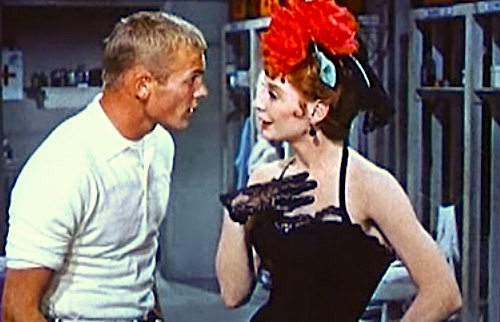
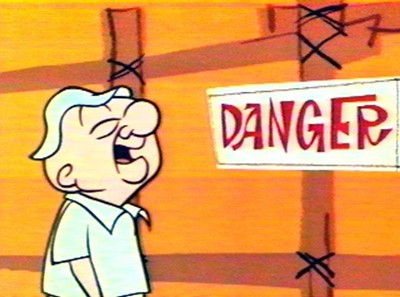
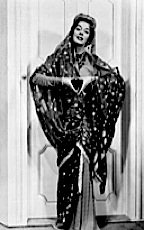






 Richard Hooker’s M*A*S*H — rejected by 21 publishing houses. {“How many Army doctors could there possibly be?” they must have scoffed. “And who else would care?”)
Richard Hooker’s M*A*S*H — rejected by 21 publishing houses. {“How many Army doctors could there possibly be?” they must have scoffed. “And who else would care?”)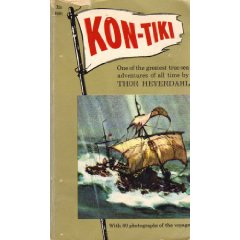 Thor Heyerdahl’s KON-TIKI — rejected by 20 publishing houses. (Yes, THAT Kon-Tiki. “This might appeal to people who sail for pleasure, but can we afford a novel for the yacht-owning niche?”)
Thor Heyerdahl’s KON-TIKI — rejected by 20 publishing houses. (Yes, THAT Kon-Tiki. “This might appeal to people who sail for pleasure, but can we afford a novel for the yacht-owning niche?”) Dr. Seuss’ first book, AND TO THINK THAT I SAW IT ON MULBERRY STREET — rejected by 23 publishing houses. (“Do we really want to confuse children?”)
Dr. Seuss’ first book, AND TO THINK THAT I SAW IT ON MULBERRY STREET — rejected by 23 publishing houses. (“Do we really want to confuse children?”) Richard Bach’s JONATHAN LIVINGSTON SEAGULL — rejected by 18 publishing houses. (“The only person I have ever known who cared about seagulls was my mad great-aunt Kate, who spent her last years wandering down to the beach to offer them caviar on crackers. Next!”)
Richard Bach’s JONATHAN LIVINGSTON SEAGULL — rejected by 18 publishing houses. (“The only person I have ever known who cared about seagulls was my mad great-aunt Kate, who spent her last years wandering down to the beach to offer them caviar on crackers. Next!”)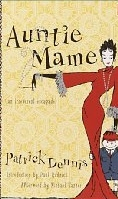 Patrick Dennis’ AUNTIE MAME — rejected by 17 publishing houses. (I have no idea what they were thinking here; perhaps that it was really the memoir it purported to be?)
Patrick Dennis’ AUNTIE MAME — rejected by 17 publishing houses. (I have no idea what they were thinking here; perhaps that it was really the memoir it purported to be?)

